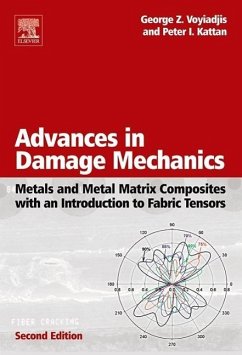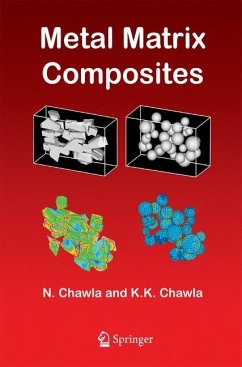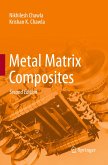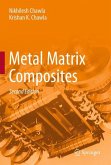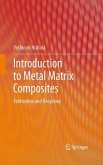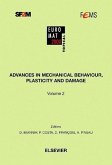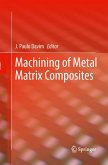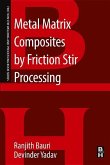George Z. Voyiadjis, Peter I. Kattan
Advances in Damage Mechanics: Metals and Metal Matrix Composites with an Introduction to Fabric Tensors
George Z. Voyiadjis, Peter I. Kattan
Advances in Damage Mechanics: Metals and Metal Matrix Composites with an Introduction to Fabric Tensors
- Gebundenes Buch
- Merkliste
- Auf die Merkliste
- Bewerten Bewerten
- Teilen
- Produkt teilen
- Produkterinnerung
- Produkterinnerung
The book presents the principles of Damage Mechanics along with the latest research findings. Both isotropic and anisotropic damage mechanisms are presented. Various damage models are presented coupled with elastic and elasto-plastic behavior. The book includes two chapters that are solely dedicated to experimental investigations conducted by the authors. In its last chapter, the book presents experimental data for damage in composite materials that appear in the literature for the first time.
Andere Kunden interessierten sich auch für
![Metal Matrix Composites Metal Matrix Composites]() Nikhilesh ChawlaMetal Matrix Composites121,99 €
Nikhilesh ChawlaMetal Matrix Composites121,99 €![Metal Matrix Composites Metal Matrix Composites]() Nikhilesh ChawlaMetal Matrix Composites121,99 €
Nikhilesh ChawlaMetal Matrix Composites121,99 €![Metal Matrix Composites Metal Matrix Composites]() Nikhilesh ChawlaMetal Matrix Composites121,99 €
Nikhilesh ChawlaMetal Matrix Composites121,99 €![Introduction to Metal Matrix Composites Introduction to Metal Matrix Composites]() Yoshinori NishidaIntroduction to Metal Matrix Composites81,99 €
Yoshinori NishidaIntroduction to Metal Matrix Composites81,99 €![Advances in Mechanical Behaviour, Plasticity and Damage Advances in Mechanical Behaviour, Plasticity and Damage]() D. MiannayAdvances in Mechanical Behaviour, Plasticity and Damage547,99 €
D. MiannayAdvances in Mechanical Behaviour, Plasticity and Damage547,99 €![Machining of Metal Matrix Composites Machining of Metal Matrix Composites]() Machining of Metal Matrix Composites81,99 €
Machining of Metal Matrix Composites81,99 €![Metal Matrix Composites by Friction Stir Processing Metal Matrix Composites by Friction Stir Processing]() Ranjit BauriMetal Matrix Composites by Friction Stir Processing77,99 €
Ranjit BauriMetal Matrix Composites by Friction Stir Processing77,99 €-
-
-
The book presents the principles of Damage Mechanics along with the latest research findings. Both isotropic and anisotropic damage mechanisms are presented. Various damage models are presented coupled with elastic and elasto-plastic behavior. The book includes two chapters that are solely dedicated to experimental investigations conducted by the authors. In its last chapter, the book presents experimental data for damage in composite materials that appear in the literature for the first time.
Hinweis: Dieser Artikel kann nur an eine deutsche Lieferadresse ausgeliefert werden.
Hinweis: Dieser Artikel kann nur an eine deutsche Lieferadresse ausgeliefert werden.
Produktdetails
- Produktdetails
- Verlag: Elsevier Science / Elsevier Science & Technology
- Artikelnr. des Verlages: B978-0-08-044688-2.X5000-0
- 2. Aufl.
- Seitenzahl: 740
- Erscheinungstermin: 1. August 2006
- Englisch
- Abmessung: 234mm
- Gewicht: 1470g
- ISBN-13: 9780080446882
- ISBN-10: 0080446884
- Artikelnr.: 21044753
- Herstellerkennzeichnung
- Libri GmbH
- Europaallee 1
- 36244 Bad Hersfeld
- gpsr@libri.de
- Verlag: Elsevier Science / Elsevier Science & Technology
- Artikelnr. des Verlages: B978-0-08-044688-2.X5000-0
- 2. Aufl.
- Seitenzahl: 740
- Erscheinungstermin: 1. August 2006
- Englisch
- Abmessung: 234mm
- Gewicht: 1470g
- ISBN-13: 9780080446882
- ISBN-10: 0080446884
- Artikelnr.: 21044753
- Herstellerkennzeichnung
- Libri GmbH
- Europaallee 1
- 36244 Bad Hersfeld
- gpsr@libri.de
Dr. Voyiadjis is a Member of the European Academy of Sciences, and Foreign Member of both the Polish Academy of Sciences, and the National Academy of Engineering of Korea. George Z. Voyiadjis is the Boyd Professor at the Louisiana State University, in the Department of Civil and Environmental Engineering. This is the highest professorial rank awarded by the Louisiana State University System. He is also the holder of the Freeport-MacMoRan Endowed Chair in Engineering. He joined the faculty of Louisiana State University in 1980. He is currently the Chair of the Department of Civil and Environmental Engineering. He holds this position since February of 2001. He also served from 1992 to 1994 as the Acting Associate Dean of the Graduate School. He currently also serves since 2012 as the Director of the Louisiana State University Center for GeoInformatics (LSU C4G; http://c4gnet.lsu.edu/c4g/ ). Voyiadjis' primary research interest is in plasticity and damage mechanics of metals, metal matrix composites, polymers and ceramics with emphasis on the theoretical modeling, numerical simulation of material behavior, and experimental correlation. Research activities of particular interest encompass macro-mechanical and micro-mechanical constitutive modeling, experimental procedures for quantification of crack densities, inelastic behavior, thermal effects, interfaces, damage, failure, fracture, impact, and numerical modeling. Dr. Voyiadjis' research has been performed on developing numerical models that aim at simulating the damage and dynamic failure response of advanced engineering materials and structures under high-speed impact loading conditions. This work will guide the development of design criteria and fabrication processes of high performance materials and structures under severe loading conditions. Emphasis is placed on survivability area that aims to develop and field a contingency armor that is thin and lightweight, but with a very high level of an overpressure protection system that provides low penetration depths. The formation of cracks and voids in the adiabatic shear bands, which are the precursors to fracture, are mainly investigated. He has two patents, over 332 refereed journal articles and 19 books (11 as editor) to his credit. He gave over 400 presentations as plenary, keynote and invited speaker as well as other talks. Over sixty two graduate students (37 Ph. D.) completed their degrees under his direction. He has also supervised numerous postdoctoral associates. Voyiadjis has been extremely successful in securing more than $30.0 million in research funds as a principal investigator/investigator from the National Science Foundation, the Department of Defense, the Air Force Office of Scientific Research, the Department of Transportation, National Oceanic and Atmospheric Administration (NOAA), and major companies such as IBM and Martin Marietta.
Chapter 1. IntroductionPart I: Isotropic Damage Mechanics - Scalar FormulationChapter 2. Uniaxial Tension in Metals Chapter 3. Uniaxial Tension in Elastic Metal Matric Composites Chapter 4. Uniaxial Tension in Elasto-Plastic Metal Matric Composites: Vector Formulation of the Overall Approach Part II: Anisotropic Damage Mechanics - Tensor FormulationChapter 5. Damage and Elasticity in Metals Chapter 6. Damage and Plasticity in Metals Chapter 7. Metal Matrix Composites - Overall Approach Chapter 8. Metal Matrix Composites - Local Approach Chapter 9. Equivalence of the Overall and Local Approaches Chapter 10. Metal Matrix Composites - Local and Interfacial Damage Chapter 11. Symmetrization of the Effective Stress Tensor Chapter 12. Experimental Damage Investigation Chapter 13. High Cyclic Fatigue Damage for Uni-Directional Metal Matrix Composites Chapter 14. Anisotropic Cyclic Damage-Plasticity Models for Metal Matrix CompositesPart III: Advanced Topics in Damage MechanicsChapter 15. Damage in Metal Matrix Composites Using the Generalized Model Cells Chapter 16. The Kinematics of Damage for Finite-Strain Elasto-Plastic Solids Chapter 17. A Coupled Anisotropic Damage Model for the Inelastic Response of Composite MaterialsPart IV: Damage Mechanics and Fabric TensorsChapter 18. Damage Mechanics and Fabric Tensors Chapter 19. Continuum Approach to Damage Mechanics of Composite Materials with Fabric Tensors Chapter 20. Micromechanical Approach to Damage Mechanics of Composite Materials with Fabric Tensors Chapter 21. Experimental Study and Fabric Tensor Quantification of Micro-Crack Distributions in Composite Materials
Chapter 1. IntroductionPart I: Isotropic Damage Mechanics - Scalar FormulationChapter 2. Uniaxial Tension in Metals Chapter 3. Uniaxial Tension in Elastic Metal Matric Composites Chapter 4. Uniaxial Tension in Elasto-Plastic Metal Matric Composites: Vector Formulation of the Overall Approach Part II: Anisotropic Damage Mechanics - Tensor FormulationChapter 5. Damage and Elasticity in Metals Chapter 6. Damage and Plasticity in Metals Chapter 7. Metal Matrix Composites - Overall Approach Chapter 8. Metal Matrix Composites - Local Approach Chapter 9. Equivalence of the Overall and Local Approaches Chapter 10. Metal Matrix Composites - Local and Interfacial Damage Chapter 11. Symmetrization of the Effective Stress Tensor Chapter 12. Experimental Damage Investigation Chapter 13. High Cyclic Fatigue Damage for Uni-Directional Metal Matrix Composites Chapter 14. Anisotropic Cyclic Damage-Plasticity Models for Metal Matrix CompositesPart III: Advanced Topics in Damage MechanicsChapter 15. Damage in Metal Matrix Composites Using the Generalized Model Cells Chapter 16. The Kinematics of Damage for Finite-Strain Elasto-Plastic Solids Chapter 17. A Coupled Anisotropic Damage Model for the Inelastic Response of Composite MaterialsPart IV: Damage Mechanics and Fabric TensorsChapter 18. Damage Mechanics and Fabric Tensors Chapter 19. Continuum Approach to Damage Mechanics of Composite Materials with Fabric Tensors Chapter 20. Micromechanical Approach to Damage Mechanics of Composite Materials with Fabric Tensors Chapter 21. Experimental Study and Fabric Tensor Quantification of Micro-Crack Distributions in Composite Materials

